[ad_1]
New Delhi: If all the votes of non-BJP candidates, independents, and NOTA were added up as one block, the BJP would have still won 224 seats in 2019 — only 48 short of the majority mark, an analysis by ThePrint shows.
In over half of the 436 constituencies where it was in the fray, the BJP secured more than 50 per cent of the vote share. In fact, the 224 seats that the BJP won by this vast vote share, is the highest for any single party since 1984.
Notably, only 136 BJP MPs secured a 50 per cent vote share or more in the 2014 Lok Sabha elections. The party has since not only upped its tally of seats with this vote share but also registered such wins across a wider geographical spread.
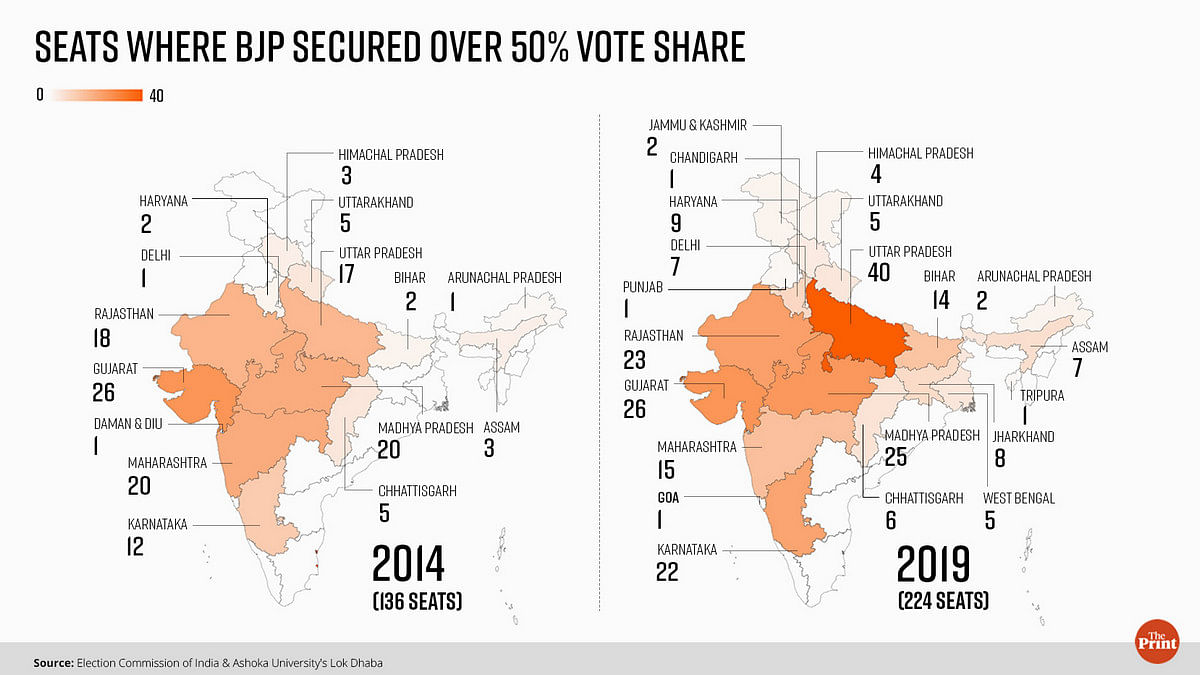
For those who are envisioning a giant coalition to take on the BJP in the 2024 Lok Sabha polls, therefore, the challenge seems tremendous. However, members of opposition parties — 15 of which met in Patna Friday to chalk out a joint strategy — claim that such numbers do not tell the whole story.
Political analysts who spoke to ThePrint took this view too.
India follows a first-past-the-post (FPTP) electoral system — where the candidate with the most votes wins regardless of whether they have a majority — so vote share only has a limited relevance, said political scientist Suhas Palshikar.
“In our FPTP system, a candidate winning by more than 50 per cent votes in a constituency does not mean much beyond the local popularity of the candidate or party. But if such constituencies increase in numbers, as in the case of BJP in 2019, it surely underscores a rising hegemony of that party,” Palshikar told ThePrint.
He added, however, that vote shares in gross percentages can only achieve so much, and parties are well aware of this.
“To win more seats, a party does not have to register only overall increase in vote share but a more systematic strategising about getting enough votes in constituencies where they lost by small margins. Most parties are aware of this and attend to this point,” he said.
According to him, the BJP must perform a balancing act in order to retain its strongholds while also upping its tally in other areas where it has less of a grip.
“The way BJP is raising the pitch on emotive issues might not necessarily end up achieving this. It now has a core constituency in various areas or regions. Getting handsome victories there, with huge margins, may demoralise the local opposition but might not help in increasing numbers of seats won,” Palshikar said.
He pointed out that deep-support constituencies and marginal-support constituencies may have very different expectations, posing a quandary for the BJP.
“The former would expect more symbolic, shrill, anti-Muslim policies and protection for vigilante action. But marginal support constituencies would expect more mundane things such as infrastructure and development,” he said.
Also Read: BJP won 105 LS seats by 3 lakh+ votes in 2019, up from 42 in 2014. What it could mean for 2024
Votes vs seats, & bright spot for opposition?
Between the last two Lok Sabha election years, the number of BJP MPs securing victories with a vote share of over 50 per cent witnessed a substantial surge, rising by 88 from 136 to 224.
In contrast, the BJP’s increase in the overall seat tally was more modest, rising by a count of 21 from 282 in 2014 to 303 in 2019.
What explains this? According to political analysts, the substantial rise in the BJP’s overall vote share by nearly eight percentage points did not translate proportionately into an increase in the number of seats. As a consequence, there was an uneven distribution of seats with higher vote shares.
Political analyst and columnist Rasheed Kidwai told ThePrint that the BJP’s rising vote share is attributable in large part to Prime Minister Narendra Modi’s charisma. During the general elections, people tend to cast votes for the PM candidate rather than for their local leaders.
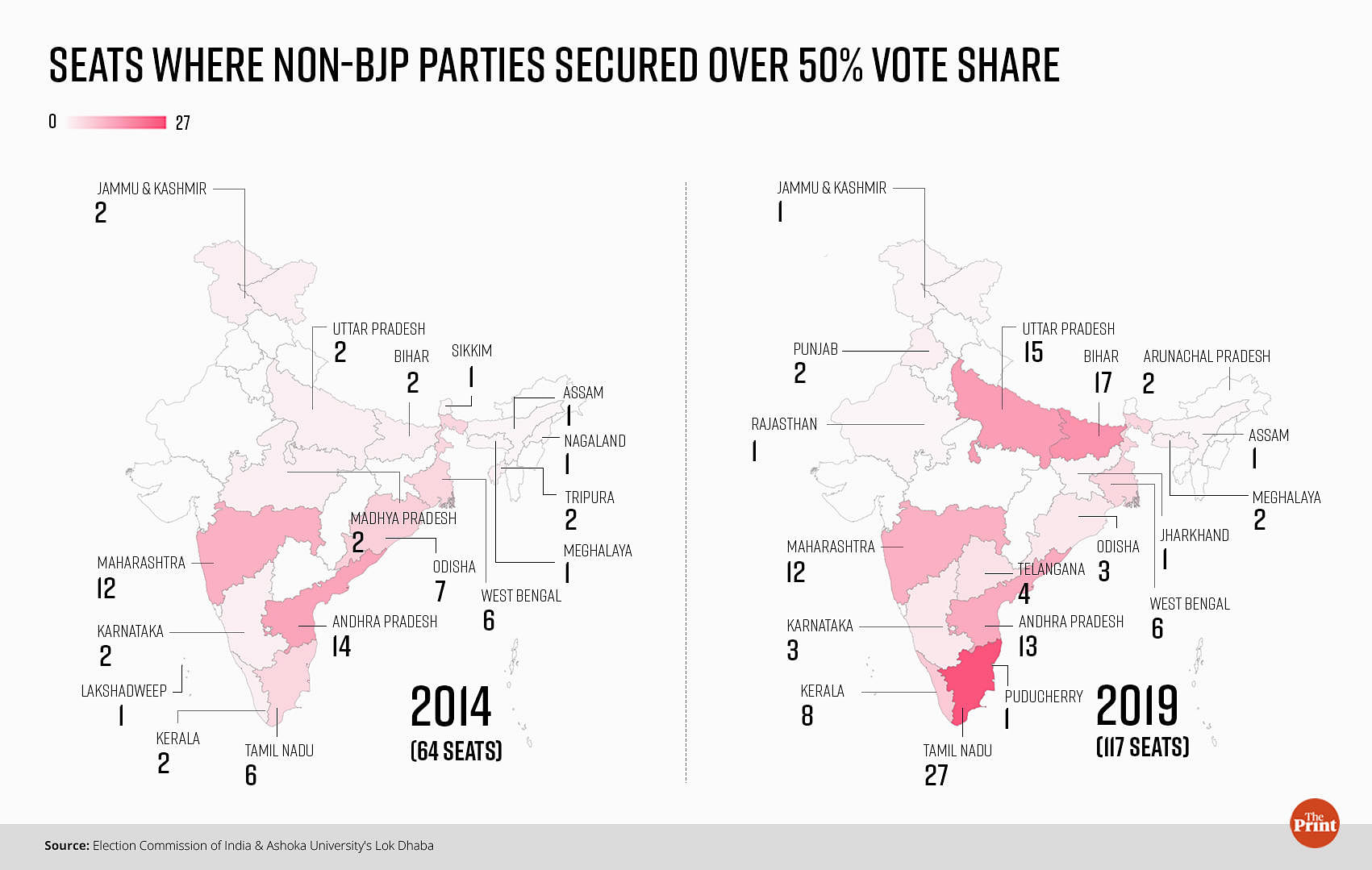
This trend is less pronounced in the assembly elections, where voting tends to be based more on local candidates and factors.
“When it comes to parliamentary elections, there is an increase of 12-25 per cent of votes for the BJP (compared to assembly elections). In Delhi, for example, the BJP got 33 per cent of the votes in the assembly state elections (in 2015), but in the parliamentary elections (in 2019), it got over 56 per cent. There is a difference between a party’s core strength and the outcome,” he said.
Kidwai said that the vote shares of BJP candidates in the Lok Sabha elections were ramping up due to Modi’s popularity rather than because of their credentials or work.
“It is kind of a windfall because of the charismatic leadership that is there,” he noted.
Another data point that sheds further light on the electoral pie in India is the vote share of non-BJP parties.
ThePrint’s analysis shows that non-BJP parties secured a vote share of 50 per cent or more in 64 seats in 2014. In the 2019 elections, this number nearly doubled to 117 seats.
Viewed as a percentage, the non-BJP parties’ seats with this vote share went up by a steep 82 per cent between 2014 and 2019. The BJP’s percentage increase was about 65 per cent.
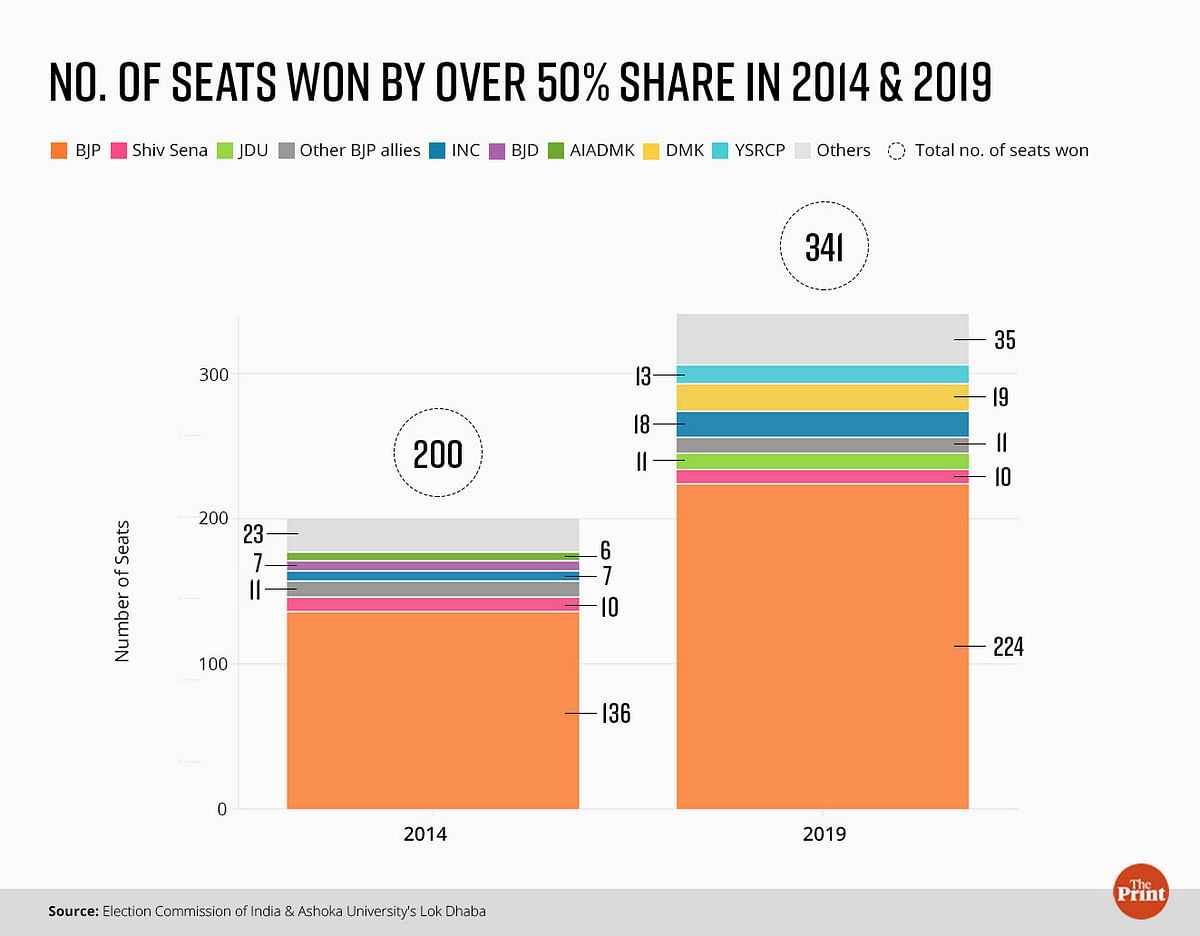
The opposition can draw some solace from this fact, but non-BJP parties in this calculation also include former National Democratic Alliance (NDA) partners like the Janata Dal (United), the Shiromani Akali Dal, and the united Shiv Sena.
While some former allies like the Nitish-Kumar-led JD(U) have now taken a strong anti-BJP stance at present, others like the Telugu Desam Party (TDP) seem to be gearing up to return to the NDA fold.
Also Read: From AIADMK, Shiv Sena to JD(U) — how BJP is growing at the cost of its allies as well as rivals
BJP & alliances
Since the 2019 elections, there have been some big changes in two electorally important states — Bihar, which has 40 Lok Sabha seats, and Maharashtra which has 48.
Bihar’s JD(U) ended its alliance with the BJP last year, while Maharashtra’s united Shiv Sena parted ways with it in November 2019.
Now JD(U)’s Nitish is busy corralling opposition parties together, while the Shiv Sena has broken into two parts, with the Eknath Shinde faction having now formed a government with the BJP in Maharashtra.
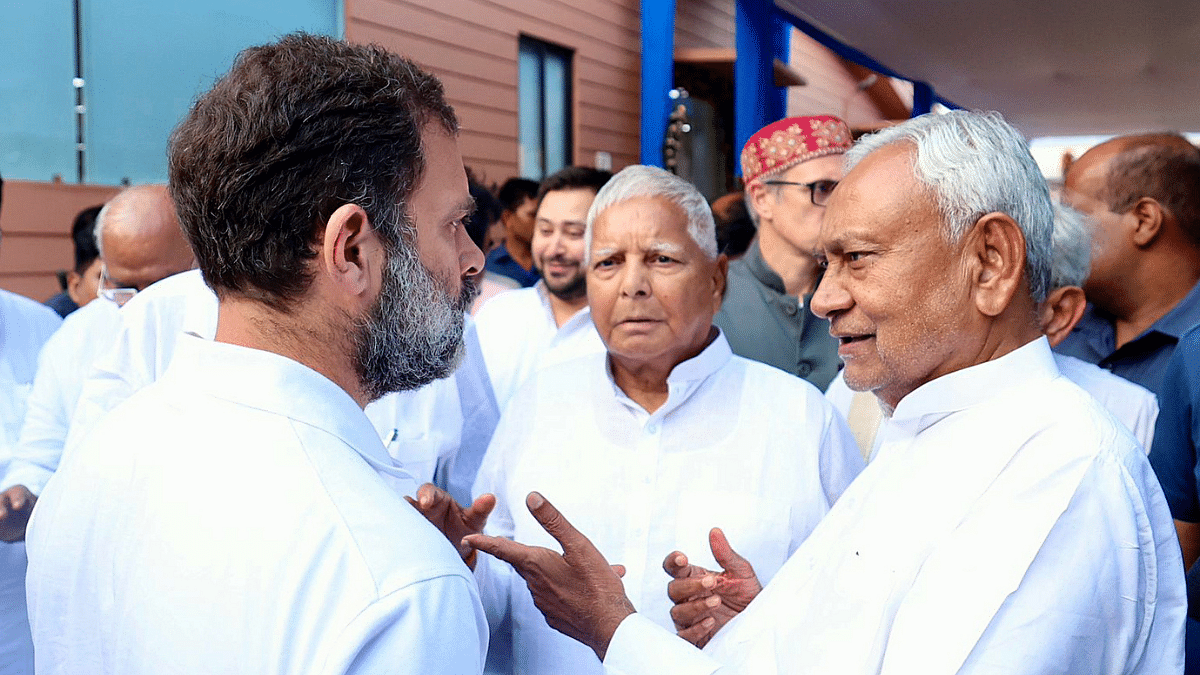
In Maharashtra, the Shiv Sena was a BJP ally in both the last Lok Sabha elections. The Sena maintained its 10 seats with over 50 per cent vote share, while the BJP’s share of such seats decreased from 20 to 15.
In Bihar, the BJP and JD(U) fought separately in 2014. The BJP won two seats with over 50 per cent vote share, while JD(U) didn’t win any by such a landslide.
However, in 2019, both parties seemed to have significantly benefited from the alliance. BJP’s 14 MPs and JD(U)’s 11 MPs won by vast vote shares, capitalising on each other’s vote banks. Additionally, their ally Lok Janshakti Party (LJP) secured six such seats.
Prof Palshikar believes that apart from vote shares, the crucial question for alliances is whether the vote is transferred or not.
He noted that the BJP feels it doesn’t require partners to garner votes in certain places, but the impact of this stance would need to be considered on a “state by state” basis.
“In Bihar, this would surely hurt the BJP. In Maharashtra, for instance, aware that it needs a partner, BJP has chosen to indulge the breakaway group of the Shiv Sena,” he observed.
A tale of 3 states — Gujarat, UP, Tamil Nadu
A look at the vote shares of parties in key states like Gujarat, Uttar Pradesh, and Tamil Nadu sheds further light on the interplay between alliances (or lack thereof) and the electoral outcomes for the BJP.
In Gujarat, the home state of the Prime Minister, the BJP rules the roost with no alliance partners. It won all 26 seats in both the 2014 and 2019 elections, with all MPs securing over 50 per cent vote share. In fact, Darshana Vikram Jardosh, now a Union minister of state, had the highest vote share percentage in the entire country, with 74.47 per cent in 2019.
In Uttar Pradesh, which has 80 Lok Sabha seats, the BJP won only 17 seats with an over 50 per cent vote share in Modi’s debut national election.
Five years on, it seemed that the BJP had a formidable fight ahead of it when the Samajwadi Party (SP), Bahujan Samaj Party (BSP), and Rashtriya Lok Dal (RLD) ganged up against it in a three-party alliance.
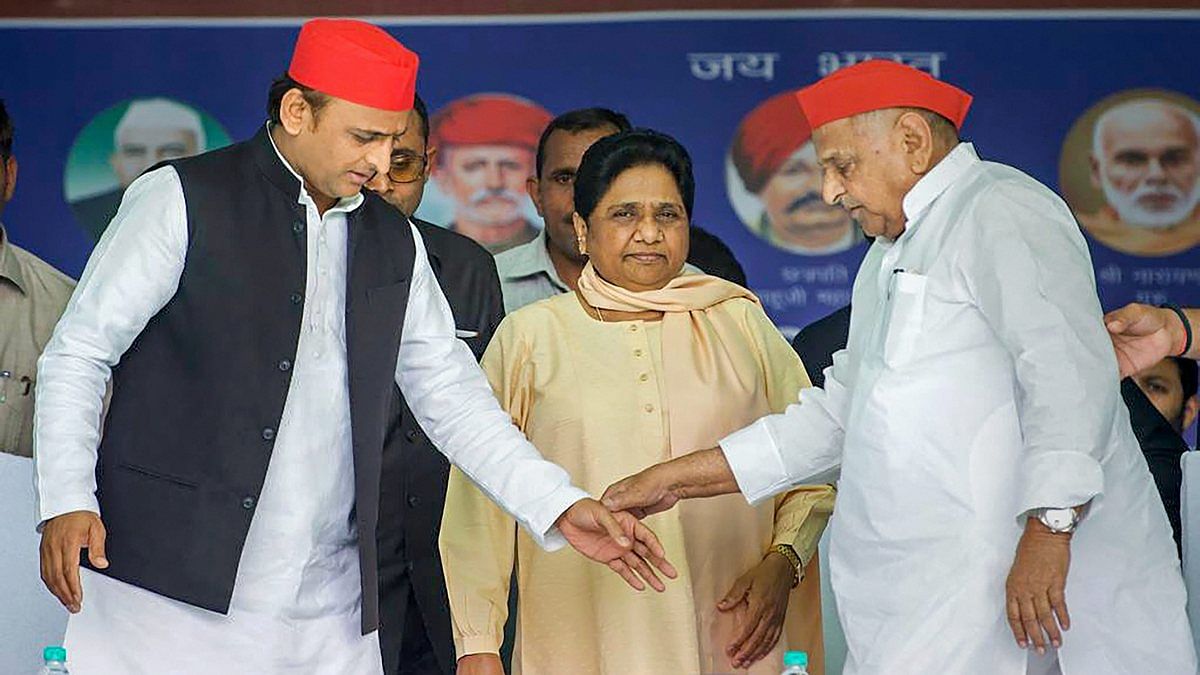
However, instead of the alliance denting the party’s prospects, the number of BJP MPs with over 50 per cent vote share increased to 40.
But this does not mean that the SP-BSP-RLD alliance didn’t reap any benefits for the parties.
In 2014, only one MP from either of the three parties had a vote share of over 50 per cent (SP’s Mulayam Singh Yadav from Mainpuri, with 60 per cent votes). At the time, all three parties fought separately.
In 2019, however, 13 MPs of the SP-BSP-RLD combine got a vote share of over 50 per cent, suggesting that the alliance may have boosted their prospects.
In Tamil Nadu, the BJP formed alliances with smaller parties in 2014, but none of the NDA candidates who won seats secured over 50 per cent vote share.
The Dravida Munnetra Kazhagam (DMK), All India Anna Dravida Munnetra Kazhagam (AIADMK), Congress, and other non-NDA parties contested separately. J Jayalalithaa’s AIADMK won six seats with over 50 per cent vote share in this election.
In the 2019 elections, an alliance comprising DMK, Congress, CPI, CPM, Viduthalai Chiruthaigal Katchi (VCK) and Indian Union Muslim League (IUML) emerged as a dominant force, securing 27 seats with over 50 per cent vote share.
Tamil Nadu, therefore, sent the third highest number of MPs with such substantial vote shares, next only to Uttar Pradesh and Bihar.
Could the Tamil Nadu results be extrapolated to mean that a large all-India alliance may be able to counter the BJP?
Prof Palshikar says that drawing such conclusions is not realistic.
“Even for the opposition, an all-India alliance does not make any sense. Much would depend on the role of state parties in a given state in defeating the BJP and the need to have additional votes,” he said.
Kidwai, on the other hand, said the finding is “significant” that some parties won more seats with over 50 per cent vote share while being in an alliance. But he cautioned that there are no guarantees.
“We have political parties who have a very strong caste- or community-based support. But when they come together to beat a stronger leader, it’s like a gamble. Sometimes it clicks, sometimes it doesn’t,” he said.
Question of ‘opposition unity’
The BJP has been actively working to secure over 50 per cent of the vote share in more seats, and the data substantiates this, claimed BJP spokesperson Gopal Krishna Agarwal, speaking to ThePrint.
“The strategy on which we are working is to get more than 50 per cent votes. From 224 we want to increase it to almost 300 seats,” he said.
Agarwal added that “opposition unity” was not something that bothered the BJP’s leadership.
“This increase in the number (of seats) shows that we are working in the right direction. There are some people who ask ‘What about opposition unity?’ Then, Amit Shah ji says that we are working on seats where we will get more than 50 per cent (vote share) so opposition unity doesn’t impact us,” he added.
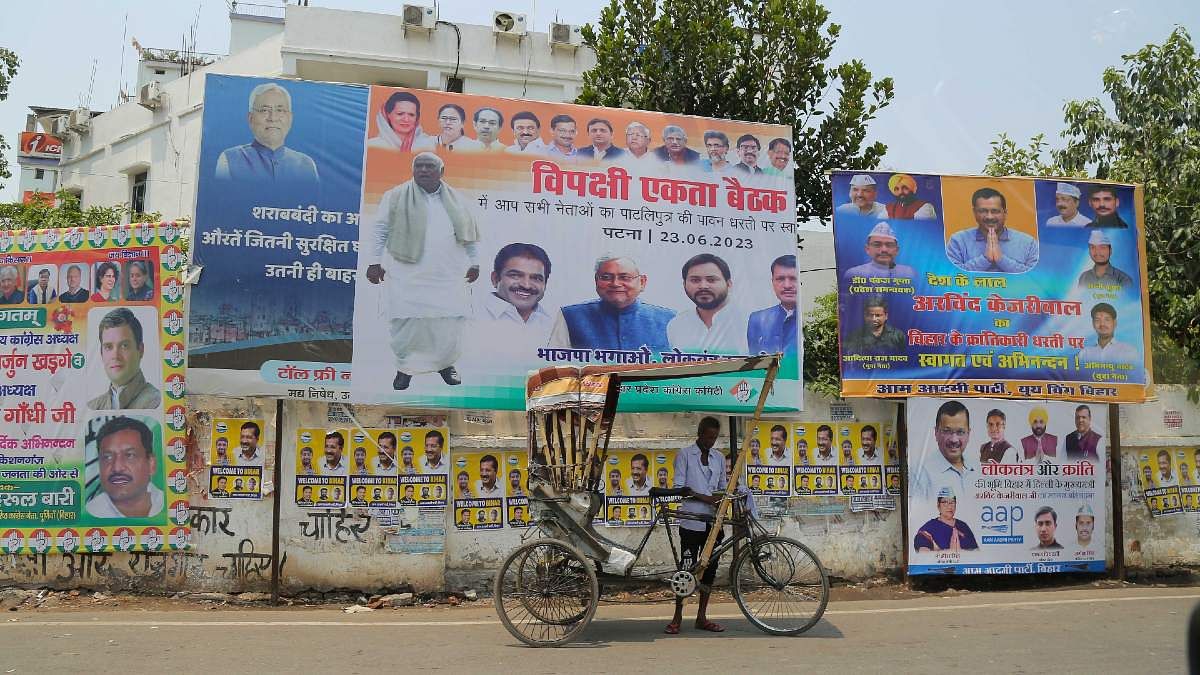
Opposition leaders, however, profess that the previous polls may not significantly predict the outcome of the 2024 elections.
Praveen Chakravarty, chairman of the Congress’s data analytics department, acknowledged that a vote share larger than 40 per cent was an “important benchmark”, but claimed things could change on a dime.
“As they say in financial markets, past performance is not an indicator of future returns,” he quipped.
In a similar vein, Salem Dharanidharan, DMK spokesperson, said many changes had taken place since 2019 and public sentiments were shifting.
“That was 2019 and the elections are in 2024. That’s five years. There is a huge difference. A lot of things have changed in the country. There was Covid and no proper care was taken for migrant workers. Poverty has dramatically increased. There have been more divisive politics,” he claimed. “The BJP does not enjoy the same confidence it did in 2019.”
According to Dharanidharan, calculations based on vote shares show that BJP can be defeated in 2024. “The BJP did not get more than 37 per cent vote share overall. The majority of their seats came from a handful of Hindi-speaking states. That means 63 per cent vote share is for the opposition,” he said.
He added that the opposition is “definitely coming together” and anti-incumbency will take care of the rest.
“Even if BJP is reduced to 200 seats, the opposition will have 300 seats. But I am sure BJP will not cross more than 150 seats and we will manage to win about 300 seats,” he claimed.
‘Remember the Indira wave…’
Asked what the BJP’s rise in vote share means for the 2024 Lok Sabha polls, Prof Palshikar said that the data shows that the party “has situated itself in a strong position”, but it remains to be seen if the trends of 2019 continue.
Kidwai pointed out that political winds had been known to change direction sharply in the past.
“Personality-driven parties tend to throw this verdict. But there is a flip side,” he said. “If you look at the 1971 elections, a lot of people won on the Indira wave, but by the 1977 elections, Indira herself lost. So, all of them lost. It’s like the winner takes it all. It is a very high-risk and high-stakes thing.”
(Edited by Asavari Singh)
Also Read: Show of strength in Karnataka, but 2024 will be an uphill task for ‘united’ opposition. Here’s why
[ad_3]










